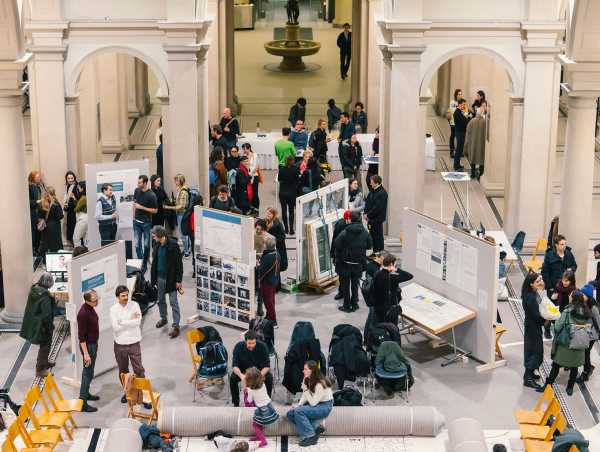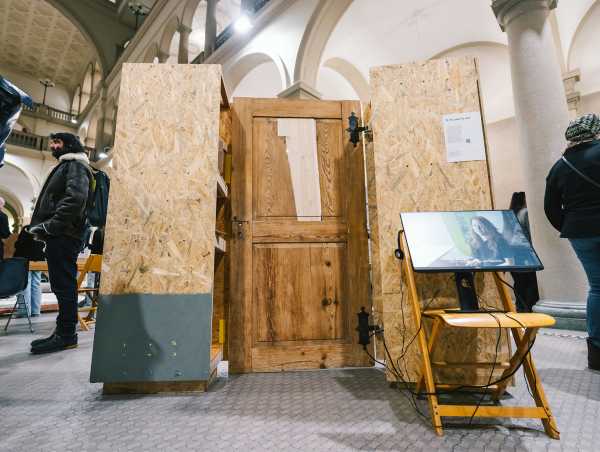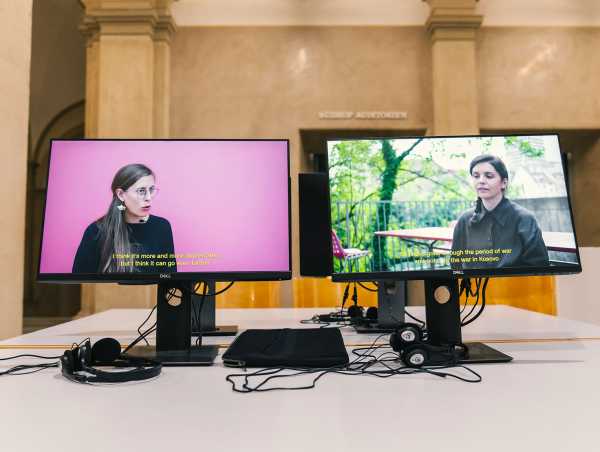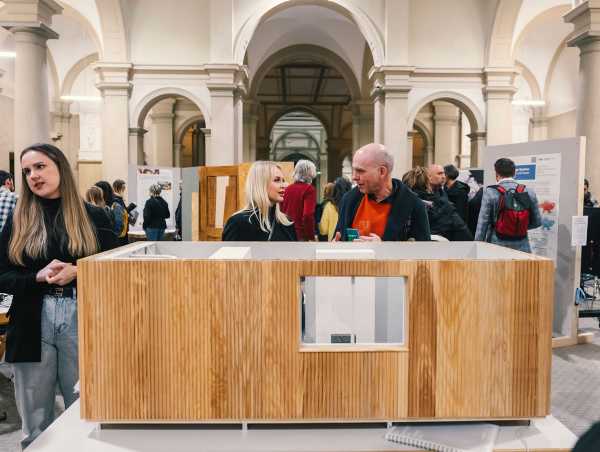How ETH knowledge and local expertise are helping the reconstruction of Ukraine
Two years ago, Russia launched its war of aggression against Ukraine. One direct consequence of the conflict is the destruction of buildings and infrastructure. Now an exhibition in the ETH Main Building entitled “ETH with Ukraine” is showing how buildings, facilities and the environment in Ukraine can be protected or restored.

In brief
- The exhibition "ETH with Ukraine-Exchanging Knowledge for a Sustainable and Resilient Future" is located in the ETH main building until February 5, 2024.
- The exhibition shows research projects that can be used to trace the course of the war and the destruction of infrastructure, as well as conceptual and practical reconstruction projects.
- With this exhibition, ETH researchers and the "Swiss Network with Ukraine" want to contribute to the exchange of experience on how Switzerland can support Ukraine in its reconstruction efforts.
Not only is the war causing immeasurable human suffering, it is also destroying vast swathes of buildings, facilities and infrastructure. Cautious estimates suggest that restoring the destroyed homes, public buildings, industrial facilities, power grids, roads, infrastructure, forests and agricultural land will cost around 400 billion dollars. “The extent of the destruction of infrastructure in Ukraine is almost unimaginable in Switzerland,” says Jonathan Banz, a scientific assistant to Andreas Wieser, Professor of Geosensors and Engineering Geodesy. “We wanted to visualise both the destruction as well as ongoing projects to maintain and rebuild the infrastructure.”
Remote sensing provides facts on destruction and construction
Together with Basil Roth, Banz is in charge of an ETH research project, Mapping Ukraine, which is looking to document the effects of the war on Ukraine’s infrastructure and environment – using geoinformation, photos and videos – and create a basis for reconstruction. The aim is to create an intuitive digital platform that provides independent information on the condition of Ukraine’s infrastructure.
Roth and Banz are not the only ETH researchers investigating the consequences of the war for Ukraine’s infrastructure. In the group led by Konrad Schindler, Professor of Photogrammetry and Remote Sensing, for example, Olivier Dietrich is using artificial intelligence to analyse satellite images. This can take a rather blurred satellite image showing the city of Mariupol surrounding the Azovstal steelworks, which were besieged for weeks, and produce a map that clearly shows the heaps of rubble in Mariupol’s cityscape. Dietrich’s research is directly linked to Mapping Ukraine, and it is also part of the external page Engineering for Humanitarian Action initiative together with the International Committee of the Red Cross.
Students, researchers and professors at ETH Zurich are using their expertise to help rebuild Ukraine. Many of them are involved in external page Swiss Network with Ukraine, which was founded by the ETH Professor Emeritus of Architecture and urban planner Kees Christiaanse, among others. To showcase these ongoing projects, researchers from the ETH Departments of Architecture and of Civil, Environmental and Geomatic Engineering, in collaboration with the network and with the external page Ukrainian Association of Students and Academics in Zurich, have now organised the exhibition entitled “ETH with Ukraine – Exchanging Knowledge for a Sustainable and Resilient Future”.
A showcase for research and local projects
A good two years after the start of the war, the exhibition opened in the main hall of the ETH Main Building on Wednesday evening. It addresses various aspects of reconstruction such as housing, refurbishment and material supply, agriculture and energy, urban development and spatial planning as well as education and culture. Rather than limiting itself to research projects, the exhibition also presents volunteer initiatives that are dedicated even now to the protection and reconstruction of buildings in Ukraine.
Exhibition «ETH with Ukraine»
 The exhibition showcases projects such as CO-HATY, which are helping to reconstruct homes and infrastructure in Ukraine.
The exhibition showcases projects such as CO-HATY, which are helping to reconstruct homes and infrastructure in Ukraine.
 In videos, Catherine de Wolf, ETH Professor of Circular Engineering for Architecture, and Albanian architect Gyler Mydyti, from Swiss Network with Ukraine, talk about approaches to reconstruction in Ukraine.
In videos, Catherine de Wolf, ETH Professor of Circular Engineering for Architecture, and Albanian architect Gyler Mydyti, from Swiss Network with Ukraine, talk about approaches to reconstruction in Ukraine. Ukrainian architect and exhibition curator Anastasiya Ponomaryova and Andreas Wieser, Professor of Geosensors and Engineering Geodesy, at the exhibition’s opening.
Ukrainian architect and exhibition curator Anastasiya Ponomaryova and Andreas Wieser, Professor of Geosensors and Engineering Geodesy, at the exhibition’s opening.  A team led by Swiss windowmaker Martin Huber developed a small three-part house made of wood, comprising a bathroom/kitchen, parlour and bedrooms for four people. So far 89 of these homes have been built in Ukraine.
A team led by Swiss windowmaker Martin Huber developed a small three-part house made of wood, comprising a bathroom/kitchen, parlour and bedrooms for four people. So far 89 of these homes have been built in Ukraine. The exhibition showcases research projects, such as satellite image analysis to track the destruction of infrastructure, as well as practical reconstruction projects for residential buildings.
The exhibition showcases research projects, such as satellite image analysis to track the destruction of infrastructure, as well as practical reconstruction projects for residential buildings. Das fünfköpfige Ausstellungs-Kuratorium (v.l.n.r.): Basil Roth, Adam Przywara, Anastasiya Ponomaryova, Gyler Mydyti und Jonathan Banz. (Bild: Christian Felber)
Das fünfköpfige Ausstellungs-Kuratorium (v.l.n.r.): Basil Roth, Adam Przywara, Anastasiya Ponomaryova, Gyler Mydyti und Jonathan Banz. (Bild: Christian Felber)
The exhibition aims to encourage an exchange of experience regarding how conceptual and technological considerations from Switzerland, together with concrete measures on the ground, can play a part in preserving and repairing settlements and facilities in Ukraine. This is something that ETH Professors Matthias Kohler and Brian Adey, as well as Christiaanse and Wieser, all agreed on at the exhibition’s opening. Accordingly, the exhibition’s five-member curatorial team was also drawn from a mix of backgrounds: Basil Roth and Jonathan Banz were joined by architect Gyler Mydyti and Adam Przywara from Swiss Network with Ukraine, as well as Ukrainian Anastasiya Ponomaryova, who until recently worked in Philip Ursprung’s History and Theory of Architecture group.
Cleaning up contaminated soil, protecting a maternity clinic
One area in which local and international initiatives are in demand is agriculture. No wonder, considering that over 4,700 square kilometres of farmland are estimated to have been contaminated. At the exhibition, environmental scientist Vira Ohorodnyk, ecologist Olena Melnyk and agricultural economist Maryna Nehrey demonstrate the ecological and political steps that can be taken to restore farmland and revitalise agricultural areas. All three fled Ukraine and are currently working at ETH.
Melnyk analysed 89 bomb craters to determine the extent to which the bombing had contaminated arable soil with heavy metals and environmental toxins. Her findings are now being taken up: at the Bern University of Applied Sciences, as part of its external page CAS Rebuild Ukraine, a group of Ukrainians is developing a strategies for how to decontaminate the soil and cultivate it in a way that safeguards people’s health, as Yevgen Getman, a member of the project, explains to ETH News. Another Ukrainian CAS participant, Kateryna Vynogradova, describes how the maternity clinic in Dnipro is being structurally reinforced so that the operating theatre and emergency department are protected in the event of bombing.
From emergency accommodation to easy-to-build homes
Several initiatives focus on housing, as the war has already destroyed well over 150,000 residential buildings and around 12 million Ukrainians have had to leave their homes. Swiss window and façade maker Martin Huber has developed an initiative for easy-to-build timber houses. He was already running a company in Ukraine before the war. Now he has led a team in Switzerland to develop a small three-part house made of wood, comprising a bathroom/kitchen, parlour and bedrooms for four people. So far 89 of these homes have been built in Ukraine. The house’s good insulation means occupants can cope with periods when the electricity or heating fails. As Mydyti, architect and one of the exhibition’s curators, explains, members of Swiss Network with Ukraine are now working together to further develop this approach and transfer it to larger apartment blocks using digital fabrication methods.
Practical reuse of building materials
In the exhibition, the model of the wooden house stands right next to a repaired wooden door and a wooden bed frame. These exhibits come from the Ukrainian project CO-HATY (which can be translated either as “to love” or as “house collaboration”). They show how Ukrainians are reusing various building materials for residential buildings. external page CO-HATY is run by the Ukrainian NGO Metalab, to which the Ukrainian architect and exhibition curator Ponomaryova also belongs. In western Ukraine, Metalab has converted six former Soviet municipal buildings into emergency accommodation for around 1,300 refugees. It is now developing further approaches to alleviate the housing shortage over the long term. For Mydyti, CO-HATY is a good example of how construction professionals in Switzerland can also learn from Ukrainian approaches to reuse building materials.
With an eye to this kind of reuse, Switzerland’s external page Re-Win association is collecting windows for Ukraine – for example, the windows of the Huber pavilions that were demolished on the ETH Hönggerberg campus are being reused in Ukraine with the involvement of Catherine de Wolf’s Chair of Circular Engineering for Architecture.